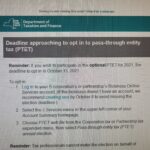Weekly Digest – October 7 2021
What does it cost to be hospitalized for COVID-19? A study by The Wall Street Journal found the cost can vary by tens of thousands of dollars, depending on the hospital and the insurance policy. While most insurers waived out-of-pocket costs for patients for most of the pandemic, many patients are now receiving bills for hospital stays, which can depend on rates negotiated between hospitals and insurers. For example, at one hospital in New York City, the cost for a severe-respiratory patient ranged from $55,182 to $94,357, depending on the insurance provider. Unfortunately, once admitted, a patient has no control over the services they receive nor over the cost.
Now that’s just the immediate “cash” outlay, as an accountant I am taught to look for things like the “opportunity cost”; as a wife, mother, friend, boss I look at not just the opportunity cost but the effect a sick loved one has on everyone around them. Not only do we work with many medical professionals, but several of my family members and friends are also in the health field, when I speak with them I ask them to be careful and stay safe so they can stay in our lives.
I am proud that our legislators have earmarked another round of stimulus funding for our country’s medical professionals, they have sacrificed so much for us. Please check out the links below under “NEWS FOR OUR MEDICAL PRACTITIONERS”, below.
As our tax season winds down, (maybe as there are several extended due dates through January 2022), see “TAX MATTERS”, below , I am feeling more and more in need of a break, I am so grateful to be able to text my crew to let them know I have taken a walk down to the beach, I did so this morning and was rewarded by not just this beautiful sunrise, but also a dolphin swimming by (it was out far so it could have been a whale). Of course I sent them a “good morning, I needed a break already” text with a photo at 7:20 AM…


At least I am wearing my accounting conference gear during my afternoon break from the office.
Raquel has been working remotely a few days a week, so when she comes in I enlist her help for a fig picking break. This week we hit our all time high with 40 figs. When I packed them in the refrigerator in give-a-way containers it reminded me of the scene in Baby Boom when Diane Keaton was snowed in on her Vermont apple orchard looking for a free space to store yet another batch of baby applesauce.

Of course my favorite scene is her value pricing scene,

If you have never seen the movie, check it out on HBO Max, I just love professional women movies, even from the 1980’s. Maybe I need a movie break right now…
THE AMERICAN RECOVERY PLAN ACT (ARPA)
Monthly Advance Child Tax Credit Payments
The deadline to unenroll from advance Child Tax Credit payments before the October 15 deadline was October 4. Nontraditional families, divorced parents, or anyone with a complicated tax situation may want to opt out from future payments to prevent a possible surprise tax bill come October.
As a reminder, if you want to opt out of future payments, you must opt out by the deadline for the next month’s payment. Check out the IRS FAQs where you’ll find everything you need to know about opting out in Section J.
TAX MATTERS
Remote Workers Beware
Did you work remotely in a different state from your regularly assigned office in 2020, and are you continuing to do so for 2021? While many states were lenient towards remote workers during 2020 due to the pandemic, those breaks may be going away for 2021, so remote workers may need to check out the precise rules for the state or states they resided in during 2021. States do not follow uniform rules about taxing income earned in that state or giving credit to you for those taxes paid to another state; 2021 may be more complex than 2020. Typically, whichever state you are a resident of will tax a portion of your income, no matter where you were when you earned it. Some states allow nonresidents to work there for 30 days or more before employers are required to withhold state taxes, while others have a wage-based threshold, and still others have no income tax (it may be time to move). Several neighboring states have reciprocal agreements so that employees who work in one state but live in the other only pay tax where they live.
We created a residency check list which you can request to see if you need to take action now to prepare for a potential multi-state tax issue. Please feel free to contact us for a copy.

And you may just confuse your dog, as my daughter Jessie did this week when she worked from home and Samson did not go to doggie day care to play with his friends (they live in Atlanta and I do love to see and share those photos of him).
Tax Deadlines Extended for Many and For Many Tax Returns
Is October 15th really the end of tax season 2021?
Residents of New York and New Jersey impacted by Hurricane Ida now have additional time to file:
- January 3, 2022 to file Federal tax returns, but there is no extension past May 15th for any taxes due with the return.
- January 3, 2022 to file New Jersey business and individual tax returns and make tax payments.
- December 14, 2021 to file New York business tax returns and make tax payments. New York business tax returns are still due October 15th with individual tax estimates and make tax payments due by December 14th.
While NJ followed the IRS announcement almost immediately, the NYS announcement came in the final hours of the September 15th “perfect storm” deadline for extended corporation tax filings and the personal and corporation 2021 estimate #3, again this does NOT include the personal tax deadline of October 15th (glad they didn’t wait any longer). This extension applies to any tax returns or tax payments that normally would be due between September 1, 2021 and December 31, 2021. Residents of Louisiana also have an extension to file tax returns and pay taxes.
FINCEN just released guidance for an extended due date for 2020 FBAR filing as well.
The NYS Pass Through Entity Tax Workaround (PTE)
The NYS 2021-2022 fiscal year budget included a potentially favorable new law that can be elected annually beginning with 2021. The Pass-through Entity Tax (PTE tax) which many businesses with operations or investors in New York may want to take advantage of this year must be elected by a partner or shareholder by October 15th. For maximum effect, the estimated tax liability should be paid by December 31, 2021. This new tax is similar to tax laws passed in several other states recently and is a way for smaller businesses (and even some larger ones) in New York to work around the recent federal tax law changes that took away previously available tax deductions for state income taxes.
Under New York’s new PTE tax, any entity taxed as a partnership or New York S Corporation may elect into the New York PTE tax system. By doing so, the entity will be voluntarily electing to pay an entity-level income tax on at least a portion of its profits allocated to its individual investors (not corporations or other partnerships) at graduated rates starting at 6.85% on taxable income of $1 or more and increasing to up to 10.9% on incomes in excess of $25 Million. Pass-through entities electing-in to the tax for this year must do so by October 15. The election must be made by March 15 for each year after 2021.
Pass-through entities included under this law are:
- Partnerships;
- federal S corporations that have made the New York S corporation election; and
- Limited liability companies (LLCs) (not operating as a Schedule C -disregarded entity).
NYS sent out a mass email notice about this the afternoon of October 6th and really stirred the pot…

We have been considering the time and cost vs the actual benefit:
State sourced income for individual partner or shareholder:
- NY/NJ/CA sourced income of $50,000 yields a personal tax benefit of $1,200
- NY/NJ/CA sourced income of $75,000 yields a personal tax benefit of $1,800
- NY/NJ/CA sourced income of $100,000 yields a personal tax benefit of $2,400
- NY/NJ/CA sourced income of $200,000 yields a personal tax benefit of $4,800
So you can see we are not so thrilled about this “great benefit”.
NJ Pass-Through Business Alternative Income Tax Act (BAIT)
P.L.2019, c.320 enacted the Pass-Through Business Alternative Income Tax Act, effective for tax years beginning on or after January 1, 2020. For New Jersey purposes, income and losses of a pass-through entity are passed through to its owners. However, the law allows pass-through entities to elect to pay tax due on the individual owner’s share of distributive proceeds. The owner(s) may then claim a refundable tax credit for the amount of tax paid by the pass-through entity on their share of distributive proceeds. The purpose is to reduce federal taxable income thereby reducing an owner’s federal taxable income, while not affecting the NJ tax liability. The tax savings grown as the business net income increases.
Pass-through entities included under this law are:
- Partnerships;
- federal S corporations that have made the New Jersey S corporation election; and
- Limited liability companies (LLCs) (not operating as a Schedule C -disregarded entity)..
The entity must have at least one member who is liable for tax on their share of distributive proceeds pursuant to the New Jersey Gross Income Tax Act, N.J.S.A. 54A:1-1 et seq., in a taxable year.
Single member limited liability companies and sole proprietorships may not elect to pay the Pass-Through Business Alternative Income Tax.
We have been considering the time and cost vs the actual benefit:
State sourced income for individual partner or shareholder:
- NY/NJ/CA sourced income of $50,000 yields a personal tax benefit of $1,200
- NY/NJ/CA sourced income of $750,000 yields a personal tax benefit of $1,800
- NY/NJ/CA sourced income of $100,000 yields a personal tax benefit of $2,400
- NY/NJ/CA sourced income of $200,000 yields a personal tax benefit of $4,800
So you can see we are not so thrilled about this “great benefit”.
NEWS FOR OUR MEDICAL PRACTITIONERS
Phase 4 of HRSA Funds Application Portal is Now Open
We have watched webinars regarding this stimulus package; here is my summary of the program take-a-ways:
This program is available to providers who serve patients with any of several different types of public coverage including Medicare parts A, B, and C Medicaid fee for service or managed-care or children’s health insurance program. Dental service providers and behavioral health providers and assisted living facilities are also eligible. This program is funded with $17 billion.
Please note the following:
- You may need to reset your password If you have not accessed the portal within 90 days
- The application portal opened on September 29, the deadline to submit a completed application is October 26, 2021 at 11:59 p.m. EST.
- If you are approved to receive a phase 4 payment it can be used to cover lost revenues or eligible expenses dating back to the beginning of the pandemic.
- If you receive a payment, the payment can be used for lost revenues and increased expenses that no other sources (PPP #1 & 2, EIDL, HHS phase 1-2-3) were used for and dating back to January 1, 2020 through March 31, 2021.
- This program was established the provide more support to smaller providers.
- Call the support hot line (866-569-3522 extension 711) for information on the progress of your application or other issues
Please use the following links and telephone number:
https://www.hrsa.gov/provider-relief/future-payments application portal
https://cares.linkhealth.com/#/ application
https://www.hrsa.gov/rural-health/about-us/definition/index.html – if not in a rural area, but you service patients who live in a rural area
https://www.hrsa.gov/provider-relief resources- fact sheet, guides
Help Hot Line: 866-569-3522 dial 711
Provider Relief Fund (PRF) Report is Now Due
You may have received a request to submit your Provider Relief Fund (PRF) report for the period that ends on September 30, 2021. This report must be submitted on line and is due by November 1, 2021. If you have not filed yet, please check your email or mail for that notice.

We have assisted several of our clients with this application, let us know if you need our assistance and we can work with you as well. Please be advised that the process is a bit time consuming so be prepared to spend at least 1 1/2 hours on a video-chat with us as we supply the necessary information for your submission. We may also need to us fill in on certain employee information and patient care data.
THE GREAT REASSESSMENT
Companies are beginning to think about how they might implement a four-day workweek as a means to safeguard their employees against burnout. But what would this look like in practice? Some companies require employees to work four ten-hour days, while others drop the required work hours from 40 to 32. Some want all employees to work the same four days, while others offer flexibility in choosing their days of work. Benefits of a four-day workweek include better work-life balance, reduced stress, and improved productivity.
Workplace perks at large firms or technology companies have traditionally centered around workplace perks such as: snacks in the kitchen, pool tables, and in-house gyms. As pandemic restrictions ease, people are looking for different kinds of perks. Employees are now interested in workplace amenities that make working at the office better than working at home. For example, urban commuters may want showers and bike racks to make commuting by bike easier. Employee-specific options for flexibility and career development pathways may help businesses attract and retain talent. However, providing customized arrays of perks and benefits to a widely dispersed workforce is more difficult than offering the same package across all team members. Sometimes the best perk is simply providing people an opportunity to do their best work: according to one expert, “If you want someone to do a good job, you don’t need to give them perks, you have to give them a good job to do.”
I would add, you also need to give them the right tools, proper support, training and guidance, set reasonable expectations and provide a comfortable workspace (remote or on site).
REOPENING THE OFFICE AND REMOTE WORK OPTIONS
Starting a new job is challenging enough, but understand that it can be more challenging for a remote worker. This piece from CNN Business offers tips to make onboarding easier.
- First, get your workspace in order with everything you think you may need.
- Review your new company’s website and social media profiles to learn as much as you can about your co-workers and company culture before you start.
- Ask your manager to assign you a buddy who can answer small questions to learn how things work.
- Ask for regular feedback from your manager in your first few weeks. This is a normal request, but more critical when you wok remotely and may be just the “trick” that helps you stay on track.
ECONOMY
Across the country, supply chain problems worsened by the pandemic are expected to continue through 2022. This Wednesday’s business section of the New York Times, sited supply chain weaknesses as a major contributor to the “bottleneck recession” of the German economy where “one in four jobs depends on exports. As Europe’s largest economy this could drastically effect global commerce.
As consumers switched spending from restaurants and live entertainment to laptops and bicycles, the pandemic exposed weaknesses in the nation’s transportation structure. At the port of Los Angeles, a lack of investment and information sharing has made it difficult for ships, cargo terminals, truckers, and railroads to work together to move freight smoothly off ships and across the country.
The biggest issue facing the Federal Reserve today is easing the tension between elevated unemployment and inflation, according to Fed Chair Jerome Powell. The U.S. is still more than five million jobs short of the pre-pandemic era, and inflation is forecast to be 4.2%, more than twice the targeted rate of 2%. At least part of the disconnect between inflation and unemployment stems from supply chain issues.
Personal spending increased by 0.8% and personal income rose by 0.2% in August according to the latest report from the Commerce Department. Wage gains and distribution of monthly child tax credit payments contributed to the increase in personal incomes. However, the spread of the delta variant slowed spending on meals and travel. However, as COVID-19 cases decline, spending is picking up in many categories, including restaurants.
GENERAL RESOURCES
- IRS resources for stimulus payments:
- Use the Get My Payment tool to check on EIP payment status
- Eligibility and general information about Economic Impact Payments
- A list of frequently asked questions for stimulus payments
- IRS information about the Advance Child Tax Credit Payments
- Portal to update information
- A list of frequently asked questions on the advance Child Tax Credit Payments
- The best source for up-to-date and accurate health information is the Center for Disease Control (CDC)
- Our Covid-19 Resource Center with relevant blog posts, videos and prior weekly newsletters
- Payroll, HR and benefits company Gusto has put together An Employer’s Guide to Navigating the Coronavirus
- Accounting Today has a special page for articles on COVID-19
- Intuit QuickBooks has a dedicated page to help small businesses
- Entrepreneur put together a listing of free tech resources for remote work
- The Consumer Financial Protection Bureau has warnings about COVID-related scams
- Fast Company has a listing of the best productivity apps for 2020
- The New York Times has an online newsletter on K-12 and higher education
- The Wall Street Journal has a collection of articles on education
- The Louvre has digitized 482,000 artworks from its collection
- PC Magazine explains how to carry your vaccination card on your phone
- How to create a strong password
We sincerely hope that you and your family are well and remain well. If you have any questions or concerns, don’t hesitate to reach out to us. We are all in this together!
Complementary Discovery Session
If you need help with your accounting, want to create a tax minimization plan, want to discuss your business growth plan or your finances, are concerned about retirement goals or need to be held accountable for your 90 day action plan, contact us for a complimentary discovery session or an appointment to just get started.
